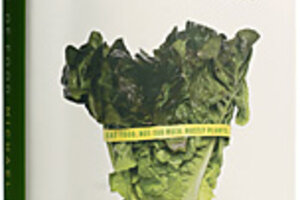Michael Pollan steps into a food fight
In his latest book, Pollan shows how nutritionism has unnecessarily complicated the act of eating.

In Defense of Food: An Eater's Manifesto By Michael Pollan The Penguin Press 244 pp., $21.95
Over the past decade, more than 10,000 books relating to diet have been published in English. In this torrent raining down on us each year one thing has become clear: Food is an enemy. Whatever happened to giving thanks for a bountiful spread before digging in? Eating used to be an act of grace, not one of terror.
Michael Pollan, journalist and author of the bestselling "The Omnivore's Dilemma," dishes up an intriguing answer in his new book In Defense of Food: An Eater's Manifesto.
Written with a matter-of-fact "let's get to the bottom of this" tone, Pollan traces the genesis of our unhappy relationship with food. The premise of his theory is that Westerners have spent so much time thinking about and tinkering with our chow that knowing how to enjoy it in a normal way is no longer clear. The science of nutrition has eclipsed the natural purpose of eating whole foods.
"The scientists haven't tested the hypothesis yet," writes Pollan in his introduction, "but I'm willing to bet that when they do they'll find an inverse correlation between the amount of time people spend worrying about nutrition and their overall health and happiness."
This is not a green light to help yourself to seconds and thirds without considering the impact. And navigating grocery stores stocked up with processed food products "elaborately festooned with health claims" still requires a certain mindfulness. But selecting your next meal doesn't have to prompt hand wringing.
Recognizing how nutritionism has complicated the act of sitting down to eat, Pollan offers seven simple words to serve as culinary guides: "Eat food. Not too much. Mostly plants."
Sounds easy, right? Not for most of us. The trouble, says Pollan, is that processed food has become so convincingly packaged that most people don't know "real" food when they see it. We can count calories, yes, but we can't spot an uncut oat.
So when did food stop becoming real food, exactly? Pollan points to several scientific, political, and cultural catalysts.
For example, the industrialization of corn and flour in the late 1800s made their products widely available and easily transportable. But the breaking-down process that occurs when rollers crush grain strips it of its nutrients. With this discovery in the 1930s, millers began adding vitamins to refined grain. However, current theories suggest that once a whole food has been broken down into nutrients some element of "food synergy" has been lost and can't be recreated by synthetically adding nutrients.
Also in the late 1800s came the wide accessibility of sugar. Sugar, combined with a broken-down flour, created food products that were more easily absorbed into the human metabolism. Thus, fast food – packed with more calories but fewer natural nutrients – was born.
By the 1970s in the United States, selling large quantities of calories as cheaply as possible became national policy.
During President Nixon's administration, "[a]gricultural policies were rewritten to encourage farmers to plant crops like corn, soy, and wheat.... Since 1980, American farmers have produced an average of 600 more calories per person per day, the price of food has fallen, portion sizes have ballooned, and predictably, we're eating a whole lot more, at least 300 more calories a day than we consumed in 1985," Pollan writes. He also points out that the 1980s mark the beginning of America's current obesity epidemic.
While Pollan doesn't advocate a meatless diet, he illustrates that vegetarians and near vegetarians are managing to avoid a highly industrialized food chain that begins with nutrient-simple grain and ends with hormone-heavy cattle in feedlots.
"Thomas Jefferson probably had the right idea when he recommended using meat more as a flavor principle than as a main course," the author writes.
The transience of health theories
However, Pollan himself spends considerable time showing how health theories evolve and then are "blown away in the gust of the most recent study."
The most classic example is the emergence of trans fats such as Crisco and margarine, once considered a healthier alternative to butter. But in recent years, butter is now back in favor and fast food restaurants are scrambling to free their menus of any traces of trans fats.
The fast pace of industry is another obvious culprit. Among 18-to-50-year-old Americans, nearly one-fifth of all eating takes place in the car. Another sobering fact about American dining rooms is that most meals take only half an hour to consume, about the length of a TV sitcom.
Pollan will succeed in making you think twice about what you are piling up in your grocery cart or on your plate. But he does offer a few personal guidelines to consider. That's where those seven words come in handy. He advocates eating locally grown food, now that it is becoming more accessible to the average city dweller. He points to the food cultures of our European cousins as examples of how to slow down and eat less. He contends that, yes, it is worth it to pay a little bit more for better quality, simpler food.
Freedom from fixation
Ultimately Pollan attempts to free food from unnecessary, man-made complexity. It's a habit worth considering, if you can set aside the irony of having to think more about food in order lessen our all-consuming fixation.
• Kendra Nordin is a Monitor staff editor.
